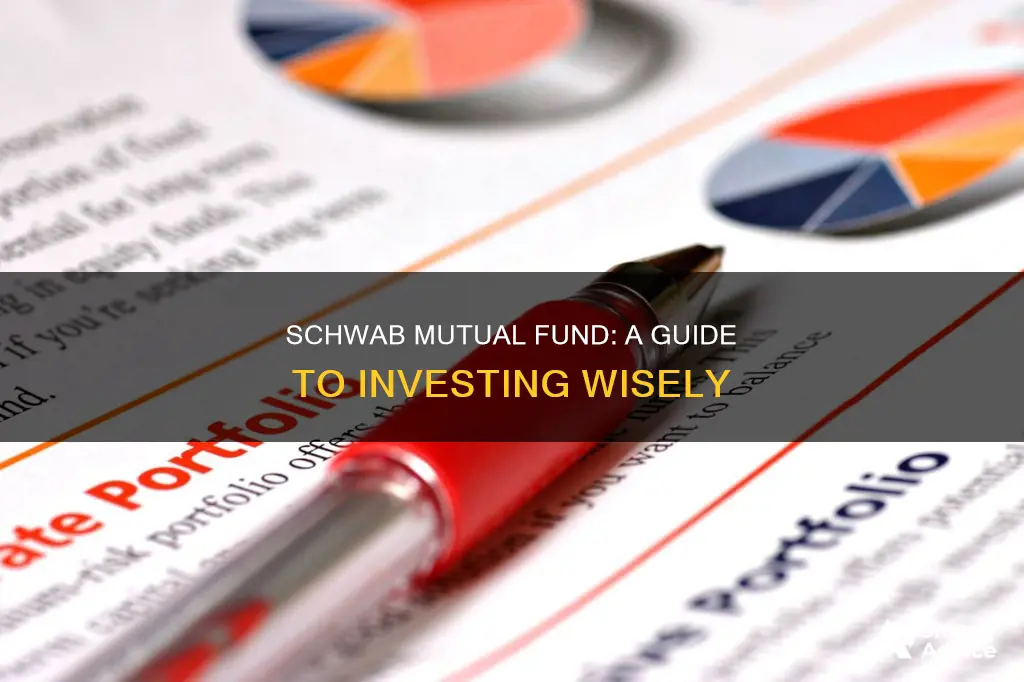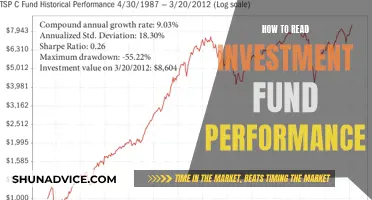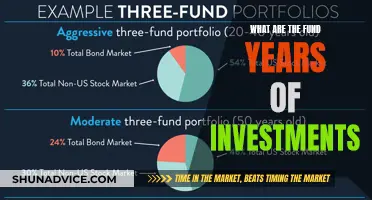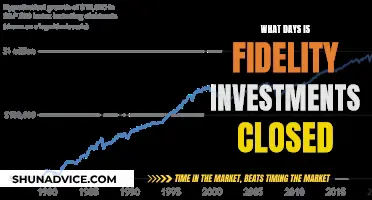
Investing in mutual funds can be a great way to build a diverse portfolio and Charles Schwab offers a wide range of mutual fund options. Schwab's Mutual Fund OneSource® service provides a list of prescreened, no-load, no-transaction-fee mutual funds that focus on performance, risk, income, and expense. The company also offers a variety of tools and resources to help investors make informed decisions, including the Mutual Fund OneSource Select List® and ETF Select List®. When investing in mutual funds, it is important to consider the operating expenses, loads, and transaction fees associated with the funds. Additionally, choosing the best mutual fund depends on the individual investor's goals and risk tolerance. Schwab offers funds across all asset classes, including commodities, European equities, and high-yield bonds, many of which have no transaction fees.
| Characteristics | Values |
|---|---|
| Investment options | Commodities, European equities, high-yield bonds, large-cap domestic stocks, international stocks, small-cap domestic stocks, cash investments, etc. |
| Investment tools | Fund Finder tool, Mutual Fund OneSource Select List®, ETF Select List® |
| Investment process | Click "Trade", choose "All-In-One Trade Ticket", select account, enter symbol or name of mutual fund, choose "Buy", enter amount to invest, select reinvestment option, select transaction fee option, click "Review Order", click "Place Order" |
| Costs | Operating expenses, loads, transaction fees |
| Operating Expense Ratio (OER) range | 0.02%-0.39% for passively managed funds, 0.21%-1.09% for actively managed funds |
| No-load and load-waived funds | Available |
| Transaction fees | $0.65 per options contract, $25 for broker-assisted trades, $5 for automated phone trades, $74.95 for trades above $100 in principal |
| Top-performing funds | Schwab S&P 500 Index Fund (SWPPX), Schwab 1000 Index Fund (SNXFX), Schwab International Index Fund (SWISX), Schwab U.S. Large-Cap Growth Index Fund (SWLGX), Schwab Health Care Fund (SWHFX), Schwab Balanced Fund (SWOBX), Schwab Target 2065 Index Fund (SWYOX) |
| Top-performing funds expense ratios | 0.02% (SWPPX), 0.05% (SNXFX), 0.06% (SWISX), 0.035% (SWLGX), 0.79% (SWHFX), 0.5% (SWOBX), 0.08% (SWYOX) |
What You'll Learn

Choose a fund that aligns with your investment goals
When choosing a mutual fund to invest in, it's important to select one that aligns with your investment goals. Charles Schwab offers a wide variety of mutual funds across all asset classes, including commodities, European equities, and high-yield bonds, many of which have no transaction fees.
To find the right fund for you, you can use the Fund Finder tool to screen for mutual funds that meet your specific criteria, such as expenses, fund performance, holdings, and Morningstar Ratings™. You can also use pre-defined screeners or create your own to identify funds that match your goals.
If you're looking for a more hands-off approach, Charles Schwab offers professionally managed mutual fund portfolios. These portfolios are selected based on goals like your approximate retirement date, desired level of monthly income, and risk tolerance. For example, the Schwab MarketTrack Growth Portfolio™ seeks high capital growth with less volatility than an all-stock portfolio, making it suitable for those with a longer time horizon and higher risk tolerance.
Additionally, Charles Schwab has teamed up with T. Rowe Price to offer actively managed mutual funds. These funds are overseen by experienced portfolio managers who carefully manage risk while maximizing the value of fund portfolios over longer time horizons.
By using the tools and resources provided by Charles Schwab, you can simplify the process of identifying funds that align with your investment goals and help you build a diversified portfolio.
International Funds: Diversify Your Portfolio, Gain Global Exposure
You may want to see also

Understand the costs and fees involved
Charles Schwab makes it a priority to ensure that investors are aware of the costs and fees involved in their investment products. When investing in mutual funds, there are three main costs to consider: operating expenses, loads, and transaction fees.
Operating Expenses
Operating expenses, also known as the Operating Expense Ratio (OER), are charged annually by the fund company and are expressed as a percentage of the fund's average net assets. OERs cover the fund's management and other operating costs. Passively managed funds typically have lower OERs than actively managed funds as they are designed to track a specific market index and do not require active fund management. At Schwab, the OER for passively managed mutual funds can range from 0.02% to 0.39%, while the OER for actively managed funds can range from 0.21% to 1.09%.
Loads
Loads are one-time commissions charged by some fund companies whenever you buy or sell shares in certain load-based mutual funds. This fee is used to compensate the broker for the sale. At Schwab, there are no-load and load-waived funds available that do not incur these fees.
Transaction Fees
Transaction fees are charged by your brokerage company when you purchase or redeem a mutual fund. This fee may also be used to compensate the brokerage in instances where it does not receive compensation from the fund. At Schwab, there are over 3,000 no-load, no-transaction-fee mutual funds available. However, for other funds, the transaction fee can be up to $74.95 per purchase.
It is important to carefully review the prospectus or summary prospectus of a mutual fund before investing, as it contains important information about the fund's investment objectives, risks, charges, and expenses. Additionally, remember that the relative importance of fees and costs depends on your investment goals and strategy.
Vanguard Funds: Best Investment Options for Now
You may want to see also

Select a fund with a good rating
When selecting a mutual fund with a good rating, it is important to remember that there is no one-size-fits-all approach. The "best" mutual fund for you will depend on your unique financial goals and risk tolerance.
To find a highly-rated mutual fund that aligns with your investment goals, you should consider the following factors:
Time Horizon:
How long do you plan to keep your money invested? If you have a short investment horizon of one to three years, debt funds are typically a more suitable option. For longer-term goals, such as retirement planning or saving for a child's education, you might opt for equity mutual funds, which are known for their potential to yield higher returns over more extended periods.
Risk Appetite:
Are you comfortable with high-risk, high-reward investments, or do you prefer a more conservative approach? Equity funds are generally riskier than debt funds, and within equity funds, small-cap funds are usually riskier than large-cap funds. If you are a conservative investor, liquid or ultra-short-term funds may be a better fit, as they offer lower-risk returns. Conversely, if you are an aggressive investor, you might consider sectoral or thematic funds, which focus on specific industries or themes and offer the potential for high returns with higher risk.
Fund Performance:
While past performance does not guarantee future results, evaluating a fund's historical returns can provide valuable insights. Look for funds that have consistently delivered returns over time, rather than chasing top-performing funds, as even the best funds can experience downturns. Additionally, consider the fund manager's skill and experience, as this can significantly impact the fund's performance.
Expense Ratio:
The expense ratio is the annual fee charged by the mutual fund for managing your investment. It covers various costs, such as management and distribution fees. A lower expense ratio means a higher net return for you, so it is generally advisable to target funds with lower expense ratios.
Liquidity:
Consider the liquidity features of the mutual fund, such as the lock-in period, exit load, and redemption limits. If you value flexibility and the option to withdraw your money when needed, an open-ended fund might be preferable. On the other hand, if you are investing for the long term, a close-ended fund with a fixed maturity period could be more suitable, as it may offer higher potential returns.
Investment Strategy:
Understand the investment strategy and philosophy of the fund manager. Ensure that it aligns with your investment style and preferences. Different mutual funds have different approaches, such as growth, dividend, or index strategies.
Tax Implications:
Different types of mutual funds have varying tax implications. For example, equity funds in India are typically taxed at 15% for short-term capital gains and 10% for long-term capital gains. In contrast, debt funds may be taxed at the marginal tax rate for short-term gains and 20% with indexation for long-term gains. Choose a fund that offers the most favourable tax treatment for your situation.
Schwab offers a Mutual Fund OneSource Select List®, which is a prescreened list of no-load, no-transaction-fee mutual funds focusing on performance, risk, income, and expense. This list can be a helpful starting point in your search for highly-rated mutual funds that align with your investment goals and risk tolerance.
The Social Security Trust Fund: Where is it Invested?
You may want to see also

Consider the fund's performance and volatility
When considering investing in a mutual fund with Charles Schwab, it is important to assess the fund's performance and volatility. Here are some key points to consider:
Performance
Schwab's Mutual Fund OneSource Select List can help you find quality mutual funds that fit your investment goals. This list focuses on performance, risk, income, and expense. The funds on this list are pre-screened and have no load or transaction fees. They are chosen based on a combination of eligibility, quantitative assessment, and qualitative review.
Volatility
Volatility refers to the constant or rapid change in the value of a fund, indicating unpredictability. When assessing the volatility of a mutual fund, you can use measures such as standard deviation and beta. Standard deviation indicates the variation of a fund's returns from the mean, with higher deviation indicating higher volatility. Beta compares the returns of a fund to a benchmark, usually the market as a whole. A beta of 1 indicates that the fund's movement is in line with the market. A beta greater than 1 means higher volatility, while a beta less than 1 suggests lower volatility.
Additionally, funds with higher expense and turnover ratios tend to have greater performance volatility. Funds with more active management, higher expenses, and higher turnover ratios are generally riskier. The level of risk you are willing to take depends on your personal risk tolerance.
By considering both the performance and volatility of a mutual fund, you can make more informed investment decisions. Remember to assess your financial goals, risk tolerance, and time horizon when choosing a fund that aligns with your investment strategy.
Strategies for Investing in George Soros' Hedge Funds
You may want to see also

Decide how much to invest
When deciding how much to invest in a Schwab mutual fund, there are several factors to consider. Firstly, it's important to assess your financial situation and determine how much capital you have available to invest. This will depend on your income, expenses, and other financial commitments. Diversification is also important, and you should consider investing across different asset classes, such as stocks, bonds, and cash. This can help reduce risk and improve long-term returns.
Another key consideration is your investment goals and risk tolerance. If you are investing for retirement, you may have a longer time horizon, which could allow for a more aggressive allocation strategy. For example, an investor who is 15 years away from retirement might consider a portfolio consisting of 50% large-cap domestic stocks, 25% international stocks, 20% small-cap domestic stocks, and 5% cash investments. On the other hand, if you are investing for the shorter term or have a lower risk tolerance, you may want to allocate more towards bonds and cash investments.
The amount you invest in each fund will also depend on the specific fund's characteristics, such as its expense ratio, historical performance, and volatility. Schwab offers a variety of mutual funds with different investment objectives, including growth, income, and target retirement date funds. You can use tools like the Morningstar rating system to evaluate funds based on their risk-adjusted performance and expense ratios. By considering your investment goals and the characteristics of each fund, you can determine how much to allocate to each one.
Additionally, it's important to consider the impact of fees and expenses on your investment returns. Mutual funds typically have operating expense ratios (OERs) that cover the fund's operating expenses, and some funds may also charge load fees or trading fees. By choosing funds with lower expense ratios and avoiding unnecessary fees, you can maximize your returns.
Finally, you may want to consult with a financial advisor or use Schwab's resources to help you decide how much to invest. Schwab offers a range of tools and resources, such as the Fund Finder tool and pre-defined screeners, to help you evaluate and compare different mutual funds. You can also open an account and speak to a qualified professional at Schwab to get personalized advice based on your financial situation and investment goals.
Get Funding for Investment Property Despite Bad Credit
You may want to see also
Frequently asked questions
First, log in to your Schwab account and select "Trade", then "All-In-One Trade Ticket". From the dropdown menu, select the account you want to use, then type in the name or symbol of the mutual fund to see the current price details. Next, choose "Buy" from the "Action" dropdown menu, enter the amount you want to invest, and select your preferred reinvestment option. If the fund has transaction fees, select your preferred transaction fee option. Finally, click "Review Order" and then "Place Order".
Here are some of Schwab's top-performing mutual funds, according to Morningstar ratings:
- Schwab S&P 500 Index Fund (SWPPX)
- Schwab 1000 Index Fund (SNXFX)
- Schwab International Index Fund (SWISX)
- Schwab U.S. Large-Cap Growth Index Fund (SWLGX)
- Schwab Health Care Fund (SWHFX)
- Schwab Balanced Fund (SWOBX)
- Schwab Target 2065 Index Fund (SWYOX)
There are three main costs to consider when investing in mutual funds: operating expenses, loads, and transaction fees. Operating expenses are charged annually by the fund company as a percentage of the fund's average net assets. Some funds charge a one-time commission called a load to compensate the broker for the sale. Finally, your brokerage company may charge a trade fee when you buy or redeem a mutual fund.







